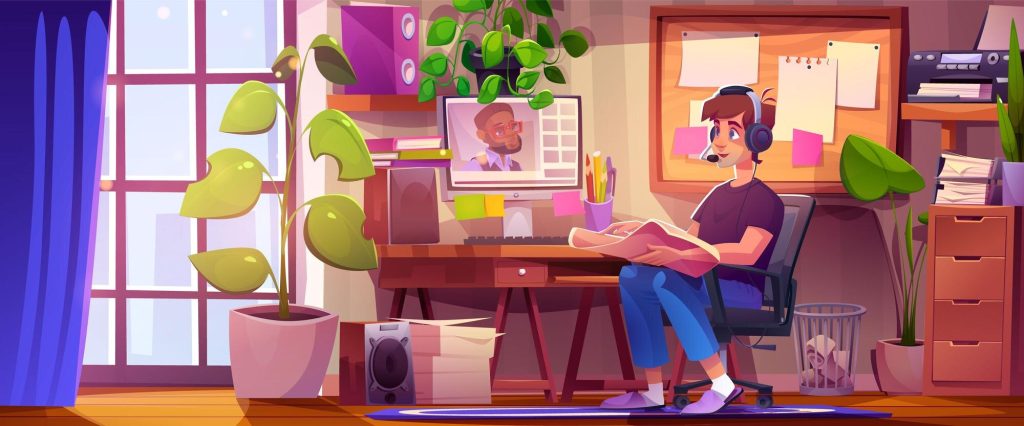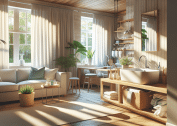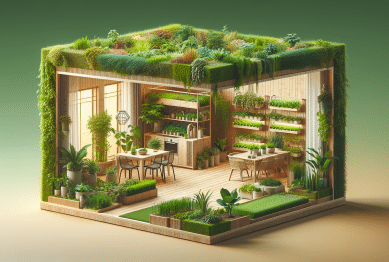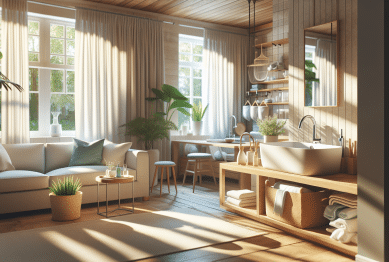In today’s fast-paced world, creating an environment of peace and tranquility can seem like a challenge, especially when dealing with small spaces. Whether it’s a compact apartment, a cluttered office, or a cozy bedroom, the space you inhabit plays a significant role in how calm and focused you feel. The good news is that organizing small spaces can have a profound impact on your mental well-being, offering clarity and reducing stress.
In this guide, we’ll explore how organizing small spaces can create a big sense of calm, offering practical tips on how to maximize your space while cultivating a more serene and functional environment.

The Psychological Benefits of Organizing Small Spaces
Before diving into the practical aspects, it’s essential to understand why organizing your space can be so effective for your mental health. Studies have shown that clutter can have a detrimental effect on your emotional state.
- Reduced Stress and Anxiety
Clutter can overwhelm your senses, leading to increased feelings of stress and anxiety. When your space is disorganized, it can make you feel out of control, adding to mental fatigue. A clean, organized space allows you to breathe easier, reducing unnecessary stress (Psychology Today, 2023). - Improved Focus and Productivity
An organized environment allows your brain to focus on the task at hand. When distractions from clutter are minimized, your ability to concentrate improves. Studies suggest that people who work in organized spaces are more productive and less likely to procrastinate (Harvard Business Review, 2023). - Better Emotional Well-being
When your living space is tidy, it can provide a sense of accomplishment and control. This feeling of control over your environment can positively affect your emotional state, contributing to an overall sense of calm (American Psychological Association, 2023).
Tips for Organizing Small Spaces
Now that we understand the benefits, let’s explore practical ways to bring order to your small space and turn it into a calm oasis.
1. Declutter First, Organize Later
The first step to organizing any space is to declutter. Start by removing items that no longer serve a purpose. This can be anything from clothes you no longer wear to old paperwork you don’t need. The fewer items you have, the easier it will be to organize the space. Here’s how:
- Sort through your belongings: Create three piles – keep, donate, and discard.
- Go through each room: Begin with areas that are most used, like the kitchen, living room, or office.
- Remove duplicate items: Keep only what you truly need and love.
Once you’ve removed the unnecessary items, the next step is organizing what remains in a way that makes your space feel less cluttered.
2. Maximize Vertical Space
In small spaces, it’s essential to think vertically. Shelves, wall hooks, and tall storage units can help you keep items off the floor and create a more open feel in the room. Consider adding floating shelves for books, plants, or decor items. Install hooks on walls or the back of doors to store bags, hats, or coats.
- Use wall-mounted storage: Install shelves or hanging organizers to keep items visible and accessible while saving floor space.
- Utilize under-bed storage: Use storage bins or drawers under the bed for extra storage without crowding your room.
- Optimize closet space: Install double hanging rods to maximize closet space and make it easier to find what you need.
By using vertical space, you create an airy atmosphere, making the room feel more spacious and organized (Vogue, 2023).
3. Invest in Multi-functional Furniture
In small spaces, every piece of furniture must do double duty. Consider investing in pieces that can serve more than one function, such as:
- A sofa that converts into a bed: Ideal for small living rooms or guest rooms, this furniture piece maximizes the available space while offering functionality.
- Storage ottomans: These can serve as both seating and a place to store extra blankets or magazines.
- Foldable tables and chairs: Great for small dining areas or home offices, foldable furniture can be put away when not in use to create a more open space.
Multi-functional furniture helps you make the most of your space while minimizing clutter (Apartment Therapy, 2023).
4. Keep Things Visible, Not Cluttered
In a small space, it’s easy to lose things in drawers or cabinets. The key to organizing is visibility. When items are easy to see and access, it makes it easier to maintain order. However, that doesn’t mean everything should be on display. Instead:
- Use clear containers: Store smaller items like office supplies, craft materials, or makeup in clear bins, so you can easily see what’s inside without opening every container.
- Organize your drawers: Drawer organizers help keep items separated and accessible.
- Open shelving for frequently used items: Items that are often used, like kitchen utensils or bathroom essentials, can be stored on open shelves to make them easily accessible while keeping the space tidy.
The goal is to create a balance between visible organization and a clean, clutter-free appearance (The Guardian, 2023).
5. Create Zones for Specific Tasks
In a small space, especially in multi-use rooms, it’s important to create clear zones for different activities. For example, in a studio apartment, you may want to designate areas for sleeping, working, and relaxing. Use furniture or rugs to visually define each space.
- Use room dividers: If your space allows, a simple bookshelf or curtain can separate different functional areas.
- Establish a workspace: Even in a small apartment, carve out a corner for work or study. Use a compact desk and ensure it’s organized with storage options.
- Create a relaxation area: Use soft lighting, a comfy chair, and a small table to create a peaceful space for reading or unwinding.
Clearly defined areas within the room will make it feel more organized and reduce the feeling of chaos (House Beautiful, 2023).
Embracing Minimalism
The more you organize and declutter, the more you’ll notice the benefits of a minimalist lifestyle. Minimalism doesn’t mean you have to sacrifice comfort or style – it’s about keeping only what you truly need and love. A minimalist approach to organization can make a small space feel much larger and more relaxing.
6. Adopt a One-In, One-Out Rule
To keep clutter from building up again, consider adopting a one-in, one-out rule. For every new item you bring into your space, commit to getting rid of something old. This will help you maintain balance and prevent unnecessary accumulation of items.
Final Thoughts
Organizing small spaces is about more than just tidying up – it’s about creating an environment that promotes peace, productivity, and calm. With a bit of creativity and some smart organization tips, you can turn even the tiniest space into a functional, calming haven. Remember, the less cluttered your space, the more you’ll be able to relax and focus on what truly matters.
References:
Vogue (2023) Maximizing Small Spaces with Vertical Storage. Available at: https://www.vogue.com (Accessed: 29 April 2025).
Apartment Therapy (2023) Smart Furniture Ideas for Small Apartments. Available at: https://www.apartmenttherapy.com (Accessed: 29 April 2025).
The Guardian (2023) How to Keep Small Spaces Organized Without Sacrificing Style. Available at: https://www.theguardian.com (Accessed: 29 April 2025).
House Beautiful (2023) How to Create Separate Zones in Small Spaces. Available at: https://www.housebeautiful.com (Accessed: 29 April 2025).









